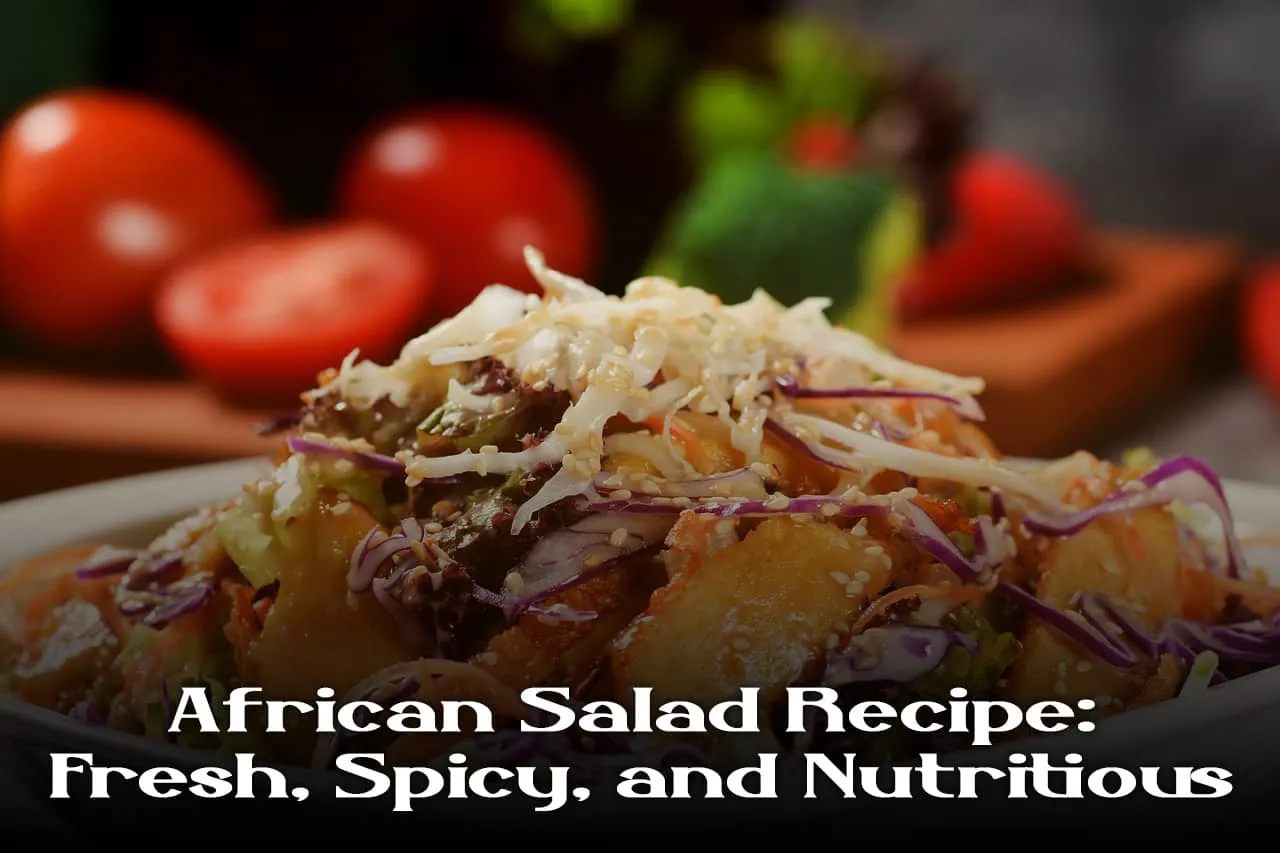If you’re looking for a dish that’s bursting with flavor, color, and culture, the African Salad Recipe: Fresh, Spicy, and Nutritious is a must-try. Popular across West Africa-especially in Nigeria-this vibrant salad brings together cassava flakes (abacha), crunchy vegetables, and a rich palm oil dressing to create a meal that’s both satisfying and wholesome.
Table of Contents
Unlike your typical leafy salad, African salad offers a bold blend of textures and spices, delivering a refreshing yet fiery taste experience. It’s not just delicious-it’s also packed with nutrients, including fiber, vitamins, and plant-based proteins that make it perfect for anyone looking to enjoy a healthy and exotic dish.
What Makes African Salad Recipe Fresh, Spicy, and Nutritious?
The African Salad Recipe: Fresh, Spicy, and Nutritious stands out because it’s more than just a meal – it’s a celebration of natural ingredients and bold African flavors. What makes this salad truly special is the perfect balance between fresh vegetables, spicy seasonings, and nutrient-rich ingredients that work together to create a satisfying and healthy dish.
When it comes to nutrition, African salad is a powerhouse. The base ingredient, cassava flakes (known as abacha), is rich in carbohydrates and fiber, helping to keep you full longer. Combined with palm oil – a source of healthy fats and antioxidants – and a variety of vegetables, this salad provides a wholesome dose of vitamins, minerals, and energy.
.
Ingredients You’ll Need for an Authentic African Salad
Main Ingredients
Cassava flakes (Abacha): The star of the dish – made from dried, shredded cassava.
Palm oil: Adds color, rich flavor, and a dose of healthy fats.
Crayfish (optional): For a savory, umami taste that enhances the salad.
Fresh vegetables: Thinly sliced onions, tomatoes, and garden eggs (African eggplants) for crunch and freshness.
Ground pepper or chili: Brings the signature spicy heat.
Utazi leaves or spinach: Adds a mild bitter note that balances the rich flavors.
Seasoning cubes and salt: For taste and balance.
Ground ehuru (calabash nutmeg): Optional but gives the salad its authentic aroma.
Boiled stockfish or smoked fish (optional): Adds protein and traditional African flavor.

Ingredient Tips for U.S. Readers
If you’re in the USA and can’t find some traditional items:
- Replace cassava flakes with shredded yucca (available in Latin markets).
- Substitute utazi leaves with baby spinach or kale.
- Use olive oil mixed with a pinch of paprika if palm oil isn’t available
Step-by-Step Guide: How to Make African Salad Recipe (Fresh, Spicy, and Nutritious)
Step 1: Soak and Prepare the Cassava Flakes (Abacha)
Place the cassava flakes in a large bowl and soak them in lukewarm water for about 10–15 minutes until they soften.
Once soft, drain the water and set the flakes aside in a sieve to remove excess moisture.
Step 2: Prepare the Palm Oil Dressing
In a clean bowl, warm the palm oil slightly (don’t overheat).
Add a small amount of potash water or baking soda solution to the oil – this helps it turn a bright orange color.
Mix in crayfish, ground pepper, seasoning cubes, and a pinch of salt. Stir well until all the spices blend into a rich, aromatic dressing.
Step 3: Add the Vegetables and Proteins
Now add your sliced onions, tomatoes, garden eggs, and optional fish or meat into the dressing.
Stir gently so the ingredients are evenly coated with the spicy palm oil mix.
Step 4: Combine Everything
Add the soaked cassava flakes (abacha) into the mixture.
Toss gently to make sure every strand of cassava is covered in the flavorful dressing.
If needed, adjust seasoning or spice levels to your taste.
Step 5: Serve and Enjoy
Serve your African Salad at room temperature or slightly chilled.
You can garnish it with utazi leaves or a sprinkle of crayfish for a beautiful finish.
Pro Tips to Elevate Your African Salad
1. Add Protein for a Filling Meal
While African salad is delicious on its own, adding grilled fish, smoked meat, or boiled eggs can turn it into a hearty, protein-rich meal. This not only enhances the flavor but also balances the nutrients for a wholesome dish.
2. Adjust the Spice to Your Taste
The key to the perfect African salad is getting the spice level just right.
- For a mild version, reduce the chili or pepper.
- For an authentic fiery kick, use freshly ground African red pepper or cayenne.
3. Don’t Skip the Palm Oil
Palm oil gives the salad its distinct flavor and bright color. If you must substitute, use olive oil with paprika, but nothing truly matches the earthy richness of real palm oil.
4. Mix Just Before Serving
To keep your salad fresh and crunchy, combine all ingredients only when you’re ready to serve. This prevents sogginess and preserves the texture of the cassava flakes and vegetables.
5. Taste as You Go
African salads rely on balance – the right amount of salt, spice, and oil can transform your dish. Taste at every stage of mixing to ensure a perfect blend of freshness, spice, and nutrition.
Common Mistakes to Avoid
- Over-soaking the cassava flakes (they’ll become mushy).
- Using too much oil – a little goes a long way.
- Skipping traditional seasonings like crayfish or ehuru, which give the salad its authentic aroma.
Health Benefits of African Salad Recipe

1. Rich in Fiber and Aids Digestion
The base ingredient, cassava flakes (abacha), is a great source of dietary fiber, which helps improve digestion and keeps you feeling full longer. This makes African salad an excellent choice for people looking to maintain a healthy weight or reduce overeating.
2. Boosts Metabolism and Immunity
The spices and peppers used in this recipe don’t just add heat – they also help boost metabolism, support blood circulation, and strengthen your immune system. The natural antioxidants in chili peppers can help your body fight off infections.
3. Packed with Vitamins and Minerals
Fresh vegetables like onions, tomatoes, and garden eggs provide essential nutrients such as vitamin C, potassium, and iron. These nutrients are vital for glowing skin, healthy blood pressure, and overall wellness.
4. Good Source of Healthy Fats
Palm oil, a key ingredient in African salad, is rich in vitamin E and beta-carotene, both known for their antioxidant properties. When used in moderation, palm oil helps maintain heart health and supports brain function.
5. Naturally Energizing and Plant-Based
African salad is mostly plant-based, making it ideal for vegetarians and anyone seeking clean, sustainable eating. Its mix of carbs, healthy fats, and proteins provides long-lasting energy without heaviness.
Perfect Pairings for African Salad
1. Grilled or Smoked Fish
Smoky, tender fish – such as tilapia, mackerel, or catfish pairs perfectly with the spicy, tangy notes of African salad. The richness of the fish complements the crunchy cassava flakes, creating a flavorful harmony on your plate.
2. Fried or Grilled Plantains
Crispy on the outside and soft inside, fried or grilled plantains add a touch of sweetness that balances the salad’s spice. It’s a classic West African pairing that never fails to impress.
3. Jollof Rice or Coconut Rice
For a fuller meal, serve your salad alongside Nigerian jollof rice or coconut rice. The spicy rice dishes pair beautifully with the cool, fresh crunch of the salad, offering a complete African dining experience.
4. Refreshing Drinks
Balance the heat of the salad with traditional African drinks like zobo (hibiscus tea), palm wine, or a simple chilled coconut water. These drinks not only refresh your palate but also enhance the tropical feel of the meal.
5. Light Bread or Flatbread
Pairing African salad with soft bread rolls or flatbread makes it easy to scoop and enjoy. This combination is filling, comforting, and perfect for casual dining.

Conclusion
The African Salad Recipe: Fresh, Spicy, and Nutritious is more than just a dish – it’s a celebration of flavor, culture, and health. With its crunchy cassava flakes, vibrant vegetables, and bold spices, this salad brings the taste of Africa right to your kitchen. Not only is it delicious and satisfying, but it’s also packed with nutrients, making it a wholesome choice for anyone looking to enjoy a healthy, exciting meal.
Whether you’re a foodie exploring global cuisines or simply looking for a fresh, spicy, and nutritious salad to brighten your day, this recipe is sure to impress.
Now it’s your turn – try this African salad at home, experiment with your favorite variations, and don’t forget to share your creations in the comments below. For more vibrant recipes like this, subscribe to our blog and bring the flavors of Africa and beyond straight to your table!

Is Abacha healthy to eat?
Yes, Abacha (cassava flakes) can be healthy when eaten in moderation. It’s rich in fiber and can be paired with vegetables and lean proteins to make a nutritious, balanced meal.
What is an African salad?
An African salad is a traditional West African dish, typically made with cassava flakes, fresh vegetables, spices, and palm oil, offering a combination of fresh, spicy, and nutritious flavors.
What are the ingredients in Abacha?
The main ingredients in Abacha include:
Cassava flakes
Palm oil
Vegetables (onions, tomatoes, garden eggs)
Spices and seasonings (ground pepper, crayfish, seasoning cubes)
Optional proteins like smoked fish or boiled eggs




